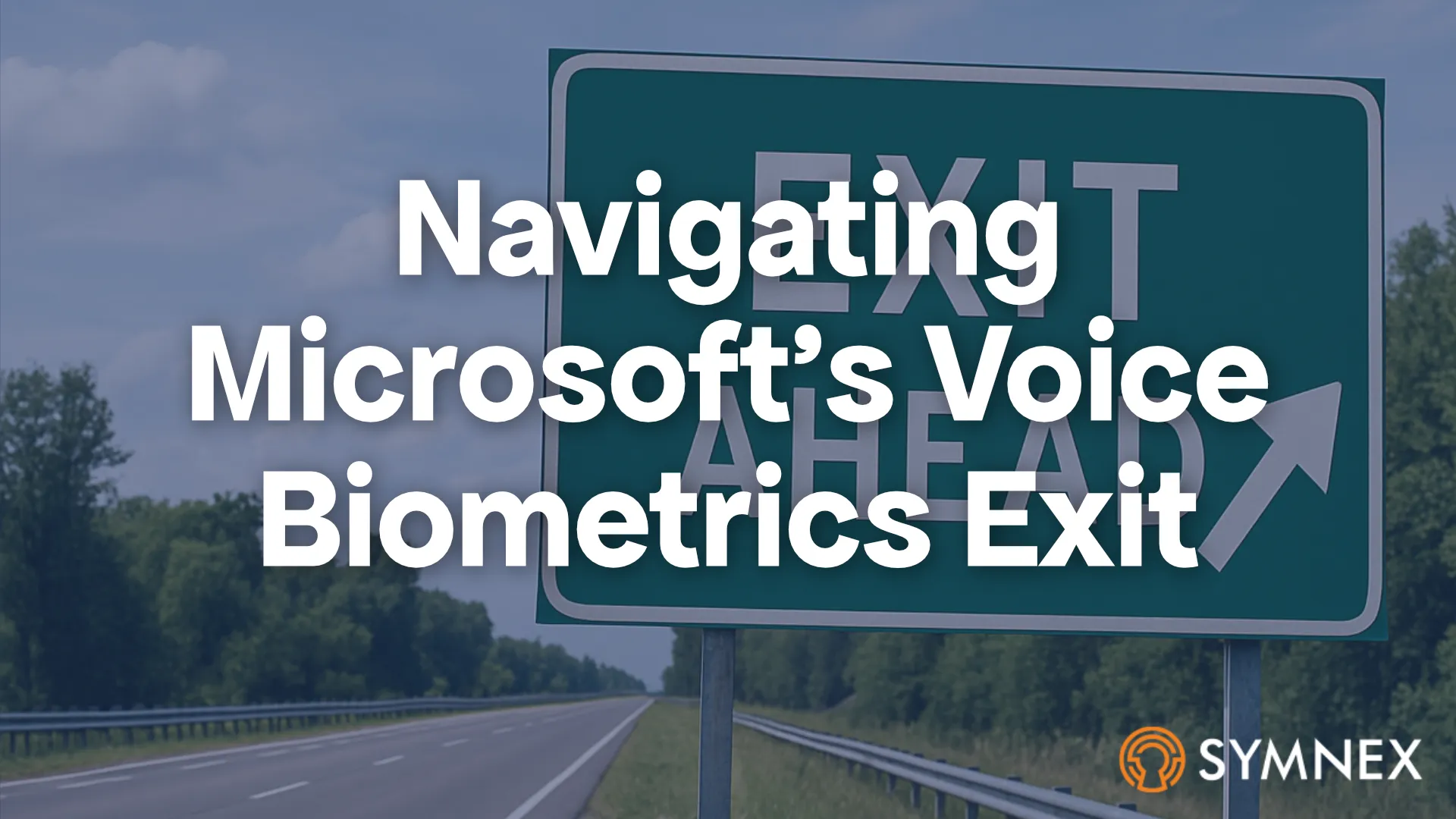This is Part 3 of my series on Microsoft's Voice Biometrics Exit:
- Part 1: What is Microsoft's Voice Biometric Endgame? - Why Microsoft will exit
- Part 2: Navigating Microsoft's Voice Biometrics Exit - Why act now
- Part 3: Voice Biometrics Partner Selection and Migration (this one) - How to transition strategically
In my previous articles, I've established Microsoft's inevitable exit from voice biometricsVoice Biometrics uses the unique properties of a speakers voice to confirm their identity (authentication) or identify them from a group of known speakers (identification). and explored why you should view this transition as a strategic opportunity rather than merely a technology replacement. With Amazon's recent announcement ending Connect Voice ID support and Microsoft's uncertain commitment to Nuance technologies, many organisations are simultaneously facing similar questions about their voice biometric futures.
This article explores the practical considerations for evaluation and migration, drawing on lessons learned from implementations across different platforms and organisational contexts.
Strategy Before Partners
The most critical mistake I see organisations make is rushing into partner evaluation before understanding what they're really trying to achieve. You need a clear strategy and roadmap before starting partner selection, otherwise you'll find yourself being heavily influenced by what they want to discuss rather than what you actually need.
Through my work with dozens of organisations, I've learned that successful transitions share a common characteristic: they begin with honest assessment and clear strategic direction.
Reassessing Your Voice Biometrics Investment
You need to understand what your current implementation actually delivers in terms of end-to-end success rate, contact coverage, operational efficiencyEfficiency is one of three measures of Call Centre Security process performance. It represents the actual and opportunity cost of the security process, for example the costs of agent time spent on manual authentication or the missed opportunity for self-service., customer experience and securitySecurity is one of three key measures of Call Centre Security process performance. It is usually expressed as the likelihood that the process allows someone who isn't who they claim to be to access the service (False Accept)., against the overall opportunity. The reality of implementation in your organisation will almost certainly differ from what was expected, with the operating environment, technology and threat having evolved significantly.
Many organisations discover they're operating well below potential, constrained by conservative design decisions made when the technology was less mature. Common areas of untapped value include improved automation with text-independent algorithms, customer registrationRegistration is the business process where a user is offered, consents to, and completes a Voice Biometric service enrolment. journeys and additional security factors. This assessment forms both your baseline for evaluating alternative providers and a roadmap for increasing value.
Understanding Your Core Assets
At the heart of every voice biometric platform lie the voiceprints of known customers and fraudsters, along with their associated metadata, including consentConsent is a step in the registration process where a user provides permission to process their biometric data before enrolment in a Voice Biometric system in a way which complies with applicable data protection and privacy legislation. records. Unfortunately, the voiceprints themselves are usually encoded in the proprietary format of the current algorithms and are therefore rarely transferable.
You need to understand where and how raw enrolmentEnrolment is a step in the registration process where specific utterances are requested from the user or previously acquired audio is used to create a Voice Biometric template (Voiceprint) for subsequent use in Authentication/Identification. and verification audio has been stored and how the relationship to your customer records is managed. If initial enrolment audio hasn't been retained, this doesn’t mean you can’t retain these customers but it does necessitate a fundamentally different migration approach. Even if the audio hasn’t been historically retained, it may make sense to start doing so now to reduce later complexity.
Operating Environment Factors
Several broader factors will significantly influence both partner selection and implementation approach:
- Data Residency Requirements - Perhaps the most determining factor in partner selection, some organisations face regulatory or policy requirements for on-premise storage of biometric assets. If this constraint exists purely from precedence rather than genuine regulatory requirement, this transition provides an opportunity to reassess, as many highly regulated organisations have found acceptable cloud-based arrangements.
- Agent Desktop Integration - Microsoft/Nuance and Amazon provided their own agent interfaces, which many customers adopted rather than developing bespoke integrations. Not every potential partner offers their own interface and in my experience, vendor-provided interfaces often fall short of the optimal design required to drive customer registrationRegistration is the business process where a user is offered, consents to, and completes a Voice Biometric service enrolment. and maximise operational efficiencyEfficiency is one of three measures of Call Centre Security process performance. It represents the actual and opportunity cost of the security process, for example the costs of agent time spent on manual authentication or the missed opportunity for self-service..
- Business Logic and Orchestration - How does your existing application integrate with other call centre technologies? Some organisations have built sophisticated orchestration around their voice biometric platform, whilst others rely primarily on vendor-provided logic. Again, the status quo may not be optimal if your fraud prevention and authenticationAuthentication is the call centre security process step in which a user's identity is confirmed. We check they are who they claim to be. It requires the use of one or more authentication factors. strategy has evolved since initial implementation.
- Contact Centre Platform Estate - Understanding your broader technology roadmap helps ensure your voice biometric migration aligns with, rather than conflicts with, other planned changes. It's also worth considering existing partners who might provide access to the required audio stream and agent desktop, such as call recording providers and fraud analytics platforms, without requiring full platform integration.
Subscribe for New Content
The Partner Landscape
Nuance has historically dominated the Voice Biometric authenticationAuthentication is the call centre security process step in which a user's identity is confirmed. We check they are who they claim to be. It requires the use of one or more authentication factors. market, with the vast majority of implementations. That does not mean that there are no alternatives but that the decision criteria are more complex, with few being able to match in terms of product maturity and implementation experience. Rather than attempt specific recommendations, I find it helpful to characterise the market into four broad categories:
- Specialised Voice BiometricsVoice Biometrics uses the unique properties of a speakers voice to confirm their identity (authentication) or identify them from a group of known speakers (identification). Providers - These typically smaller firms focus exclusively on voice biometrics, though some may cover related speech technologies. They generally offerOffer is a step in the registration process where a user is introduced to and offered enrolment in a Voice Biometric service. the most advanced algorithms and features but may require more integration effort with your existing platform. Their specialisation often translates to deeper expertise and more responsive support for technical issues. Best suited for organisations with complex requirements, strong internal technical teams, or unique use cases requiring deep customisation.
- SecuritySecurity is one of three key measures of Call Centre Security process performance. It is usually expressed as the likelihood that the process allows someone who isn't who they claim to be to access the service (False Accept). and Identity Platforms - These broader security platforms include voice biometrics within their suite of authentication and fraud prevention technologies. They excel at orchestrating a unified security approach across channels and authentication methods. Some potential partners sit between these first two categories and offer a balance of breadth of coverage and depth of experience, but others may lack the voice biometric sophistication of the specialists. Best suited for organisations seeking unified security across multiple channels or those already using broader security platforms.
- Call Recording and Customer Experience Platforms - With their experience processing audio and integrating with agent desktops, these providers can add voice biometric capabilities to their suites. They often benefit from large training datasets and tight integration with existing capabilities. Best suited for organisations prioritising integration with existing contact centre infrastructure or those seeking broader analytics capabilities.
- Contact Centre Platforms with Voice Biometrics - Increasingly, major contact centre platforms offer voice biometric capabilities, either through partnerships or native development. Whilst convenient for organisations already using these platforms, these solutions may offer less flexibility and control than independent options. Best suited for organisations with straightforward requirements willing to trade flexibility for convenience—though Amazon Connect Voice ID's fate demonstrates the risks of this approach.
For existing users of Nuance Security Suite, Microsoft/Nuance Gatekeeper, or Amazon Connect Voice ID, the most appropriate solutions are likely to come from specialist or security platform providers, as these categories typically offer the enterprise capabilities and migration experience you'll require.
What Drives Success
Through my work with organisations across different platforms, I've observed consistent patterns in what separates successful implementations from disappointing ones. The factors that matter most are rarely the ones that feature prominently in vendor demonstrations or Request for Proposal (RFP) responses.
Unfortunately, the easy-to-measure features like performance benchmarks, price per call and integration certifications aren't the ones that will determine your success. Any self-respecting team with sufficient resources can create a performant engine that beats historic performance criteria in laboratory conditions, but does it scale in your environment? How will it handle the short utterances typically obtained in automated use cases? A low price per call is meaningless if it requires three years of operating expenses to integrate with your line-of-business applications, or doesn't provide the flexibility you need to maximise customer registrationRegistration is the business process where a user is offered, consents to, and completes a Voice Biometric service enrolment..
Whether a provider is certified for a particular platform is meaningless, given that the integration patterns are largely the same under the hood. Best-in-class synthetic speech detectionSynthetic Speech Detection is a mechanism used to protect Voice Biometrics systems from presentation attacks using synthetic speech. It relies on detecting characteristics inherent in the text-to-speech (TTS) generation process. is a liability if there's no team and process to continuously update it in the face of new and evolving threats.
As we've seen from Amazon Connect Voice ID's sudden termination and Microsoft's retreat from voice biometricsVoice Biometrics uses the unique properties of a speakers voice to confirm their identity (authentication) or identify them from a group of known speakers (identification)., the hard-to-measure intangibles such as long-term commitment, deep experience and operational flexibility are probably the most important factors in partner selection. These qualities will help you deliver quickly and effectively, yet no potential partner will admit they lack them, which is precisely why you will benefit from independent assessment of vendor capabilities.
Migration Approaches
Every migration I've observed has followed one of several broad patterns, each with distinct characteristics. Understanding these patterns can help you determine the most appropriate approach for your specific context, though the reality is that most migrations end up being a hybrid of two or more:
- Big Bang Migration - Callers are re-enrolled offline in the target platform using data and audio from the legacy platform, with periodic synchronisation until switchover. This approach can provide cleaner data management but requires comprehensive testing and robust rollback planning.
- Phased Migration - Where you can segregate callers by line of business, agent group, or desktop platform, you may be able to move some caller groups ahead of others. This can reduce risk but creates operational complexity in managing multiple platforms simultaneously.
- Background Re-enrolmentEnrolment is a step in the registration process where specific utterances are requested from the user or previously acquired audio is used to create a Voice Biometric template (Voiceprint) for subsequent use in Authentication/Identification. - The target platform runs in the background, relying on the legacy platform for authenticationAuthentication is the call centre security process step in which a user's identity is confirmed. We check they are who they claim to be. It requires the use of one or more authentication factors. whilst enrolling callers as they call. This approach is generally required where audio hasn't been retained in the legacy platform and offline re-enrolment isn't possible. At some point, a decision needs to be made to turn off the legacy platform.
- Parallel Running - Both platforms operate simultaneously, with additional orchestration determining which platform to use for each caller. This is the most complex scenario but can provide maximum fallback capability during transition.
The choice between these approaches depends primarily on your audio retention, operational complexity tolerance and risk appetite. Each has been used successfully, but they require different levels of technical sophistication and project management oversight.
Implementation Considerations
It's worth acknowledging that voice biometric migrations often encounter unexpected complexities. This isn't necessarily a reflection of partner capability or organisational competence, it's more often a consequence of the need to plan for and mitigate potential risks and interruptions to service.
Every migration presents unique challenges, but successful organisations plan for this with realistic timelines, effective risk identificationIdentification is call centre security process step in which an individual record is found in the organisation's systems of record. In this step users claim an Identity. and mitigation, thorough testing, rehearsals and flexible contingency plans.
Subscribe for New Content
Next Steps
This series has explored Microsoft's voice biometric trajectory and the implications for organisations relying on these technologies. Whether you're facing immediate migration pressure or planning for eventual transition, the organisations that navigate these transitions most successfully share certain characteristics: they understand their current performance and assets, develop clear strategies before evaluating partners and approach evaluation with criteria based on their specific context rather than generic feature comparisons. Most importantly, they recognise that migration success depends as much on implementation methodology as on technology selection and they use this forced transition as an opportunity to unlock greater value from their voice biometric investment.
For those beginning this journey, the advantage lies in starting whilst you still have choices. Whether that's 18 months or 18 weeks, a considered approach will deliver better outcomes than reactive decision-making.
The forced nature of this transition may feel like a constraint, but it also provides the business justification and stakeholder attention that many voice biometric optimisation projects struggle to achieve. Used wisely, this disruption can unlock significantly greater value from your voice biometric investment.
I work with organisations navigating voice biometric transitions, helping them understand their options and develop appropriate strategies. If you'd like to discuss your specific situation, you can book a time here or contact me directly.


